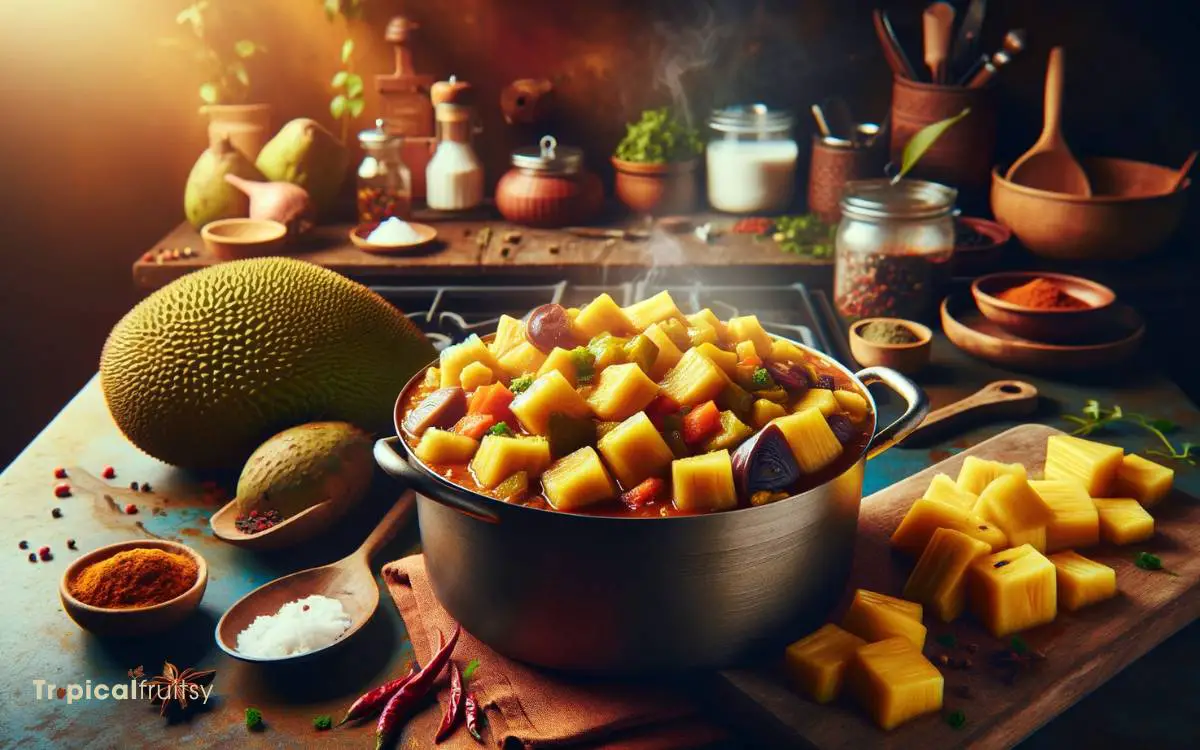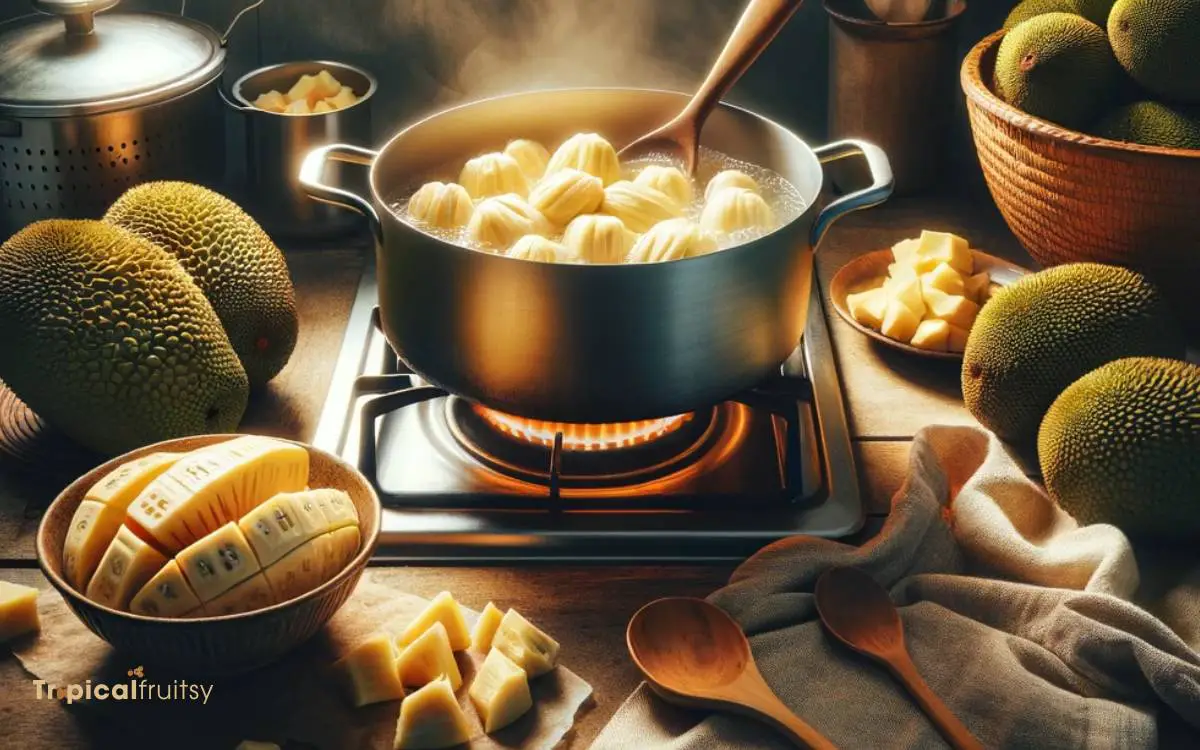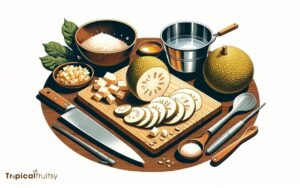How to Cook Overripe Breadfruit? 6 Easy Steps!
Transform overripe breadfruit into a culinary delight with our comprehensive guide. Discover sweet and savory recipes, including pancakes, fritters, and curries, that highlight the unique flavor of this tropical fruit.
Overripe breadfruit is characterized by its soft texture and heightened sweetness. To determine if breadfruit is overripe, look for a soft feel and a fragrant, sweet smell.
When preparing overripe breadfruit, it’s important to remove the skin and core before using it in recipes.
Some popular ways to utilize overripe breadfruit in cooking include making breadfruit pancakes, fritters, or even a savory curry.
For those looking to preserve the fruit, techniques such as freezing or making breadfruit flour are also beneficial.
Discover the sweetness of overripe breadfruit in your kitchen with these creative and delicious cooking methods.

Key Takeaway
Step 1: Assessing Breadfruit Ripeness

Before cooking, it is essential to ascertain the ripeness of the breadfruit, as its textural and flavor profile changes significantly with maturity.
An overripe breadfruit manifests a profound transformation, characterized by a softening of the pericarp and a deepening of the interior hue to a custard-like, creamy yellow.
The olfactory indicators are equally pronounced; a mature breadfruit emits a sweet, musky aroma, a stark contrast to the subtle, grassy notes of its less mature counterpart.
To evaluate, one must employ a tactile examination, gently pressing the surface to detect a yielding consistency.
Moreover, the auditory test—tapping the breadfruit for a resonant, hollow sound—can confirm ripeness.
These diagnostic approaches are paramount to culinary endeavors, ensuring the breadfruit’s gastronomic potential is fully realized.
Step 2: Preparing Your Breadfruit

Transitioning from the evaluation of ripeness, the preparation of overripe breadfruit requires meticulous attention to ensure the preservation of its delicate textures and flavors.
Commence by washing the exterior with care, utilizing a gentle scrub to remove any residual organic matter. With a sharp knife, excise the stem and base, then longitudinally bisect the fruit to expose the core.
Carefully extract the fibrous heart and any seeds present, taking care not to disrupt the surrounding flesh.
Next, segment the halves into wedges for facile handling. If the intention is to cook the breadfruit in its skin, make incisions to allow heat penetration.
This methodical approach primes the breadfruit for culinary transformation, perfectly leading us to the subsequent culinary delight: sweet breadfruit pancakes.
Step 3: Sweet Breadfruit Pancakes

Having prepared the overripe breadfruit, one can now repurpose it into a delightful breakfast option by crafting sweet breadfruit pancakes, a recipe that showcases the fruit’s unique texture and sweetness.
This innovative utilization not only minimizes food waste but also offers a sumptuous alternative to traditional pancakes.
The natural sugars within the breadfruit caramelize upon cooking, providing a subtle sweetness that pairs exquisitely with the following ingredients:
- Mashed overripe breadfruit
- Whole wheat flour for a healthier twist
- A hint of cinnamon to complement the breadfruit’s flavor profile
- A dash of vanilla extract to enhance the overall aroma
- A sprinkle of nutmeg for an aromatic depth
These components amalgamate to form a batter that, when cooked to golden perfection, yields pancakes with a tender crumb and a satisfying edge of crispness.
Step 4: Savory Breadfruit Fritters

Savory breadfruit fritters offer a delectable way to transform overripe breadfruit into a crisp, golden appetizer or side dish.
To commence, the breadfruit’s soft, creamy interior is extracted and mixed with a mélange of finely chopped aromatics—onions, garlic, and herbs—that infuse the fleshy canvas with robust flavors.
This amalgamation is then seasoned with salt, pepper, and a whisper of spice, tailored to one’s preference for heat.
Binding agents, such as a light dusting of flour or cornstarch, are introduced to the mixture to ensure structural integrity upon frying.
Subsequently, spoonfuls of the seasoned blend are delicately deposited into hot oil, where they metamorphose into fritters with a satisfyingly crunchy exterior. The finished product emerges as an inviting symphony of textures and tastes.
Step 5: Breadfruit Curry Delight

A generous amount of overripe breadfruit serves as the foundation for a rich and aromatic Breadfruit Curry Delight, a dish that brings a tropical twist to the classic curry.
The naturally sweet and creamy texture of the fruit complements the complex blend of spices, creating a symphony of flavors that are both comforting and exotic.
To captivate your culinary senses, consider the following elements that are integral to this dish:
- Ripe, succulent breadfruit, cubed and ready to absorb the spices
- A harmonious blend of curry powder, turmeric, and cumin
- The sweetness of caramelized onions
- A splash of coconut milk for a silky finish
- A hint of chili for a subtle, yet invigorating kick
Crafted with precision, this Breadfruit Curry Delight promises to satisfy those seeking a unique and flavorful experience.
Step 6: Preserving Overripe Breadfruit

Transitioning from the preparation of a Breadfruit Curry Delight, it is essential to consider methods for preserving overripe breadfruit to extend its usability and reduce food waste.
Employing preservation techniques not only maximizes the fruit’s value but also contributes to a sustainable kitchen practice.
Herein, we delineate effective preservation strategies:
| Preservation Method | Description |
|---|---|
| Freezing | Peel and cut the overripe breadfruit into chunks, blanch if desired, then freeze in airtight containers or freezer bags. |
| Dehydrating | Slice the breadfruit thinly and dehydrate at a low temperature until completely dry, then store in a cool, dry place. |
| Pickling | Create a pickling solution with vinegar, water, and spices, and submerge breadfruit slices for a tangy preserve. |
| Canning | Process breadfruit in a boiling water canner after packing into jars, preserving in syrup or juice. |
| Fermenting | Use lacto-fermentation with salt brine to ferment breadfruit pieces, producing a probiotic-rich food. |
Each method offers a unique texture and flavor profile, catering to diverse culinary applications and extending the life of this tropical bounty.
Can Overripe Breadfruit be Used for Cooking in the Same Way as Fresh Breadfruit?
Yes, overripe breadfruit can still be used for cooking in the same way as fresh breadfruit. To prepare breadfruit to eat, simply remove the skin, seeds, and any discolored spots before cooking. Overripe breadfruit may be softer and sweeter, but it can still be used in various dishes.
How to Cook Ripe Breadfruit

Cooking ripe breadfruit is a versatile and tasty way to enjoy this tropical fruit.
Here’s a basic method to cook it:
Peeling and Cutting:
- First, rinse the breadfruit thoroughly.
- Slice off the stem and base.
- Peel the skin using a knife, similar to how you would peel a potato.
- Cut the breadfruit into quarters and remove the core.
Boiling:
- Place the cut breadfruit in a pot of water. Ensure the pieces are fully submerged.
- Add a pinch of salt.
- Bring the water to a boil, then reduce to a simmer.
- Cook for about 15 to 20 minutes, or until the pieces are soft and tender.
Frying (Optional):
- If you prefer, you can fry the boiled breadfruit.
- Slice the boiled pieces into smaller chunks or slices.
- Heat oil in a frying pan.
- Fry the pieces until they are golden brown on each side.
Baking or Roasting:
- Preheat your oven to 375°F (190°C).
- Cut the breadfruit into slices or wedges.
- Toss with a bit of oil and seasoning of your choice.
- Bake for about 20-30 minutes, turning halfway, until the pieces are golden and crispy.
Serving:
- Breadfruit can be served as a side dish, similar to potatoes.
- It pairs well with both savory and sweet toppings.
Remember, ripe breadfruit will be softer and sweeter, so it’s great for dishes where a slightly sweet flavor is desired.
Enjoy experimenting with different recipes and flavors!
Conclusion
The versatility of overripe breadfruit is evident through its incorporation into sweet pancakes, savory fritters, and aromatic curries.
These adaptations not only reduce food waste but also enrich culinary diversity.
A notable statistic is that nearly 40% of food produced globally is wasted, highlighting the importance of innovative recipes that utilize overripe produce.
The techniques discussed serve as a sustainable approach to food consumption, contributing to a more resource-efficient gastronomy.






